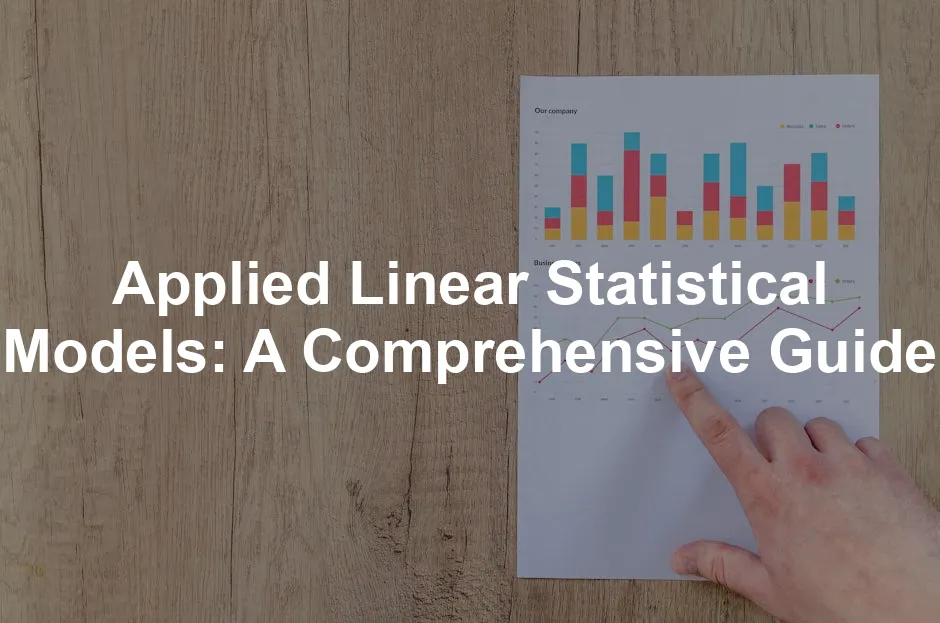Introduction
Applied linear statistical models are the backbone of data analysis. They help us make sense of numbers in various fields like social sciences, business, and healthcare. Imagine trying to predict how a new advertising campaign might influence sales. That’s where these models shine!
Understanding applied linear statistical models is crucial. They enable researchers and analysts to draw meaningful conclusions from data, guiding important decisions. In healthcare, for instance, these models help assess treatment effectiveness. In business, they predict market trends. Without them, decision-making would be like sailing a ship without a compass—confusing and risky.
If you’re looking to dive deeper into the world of data analysis, consider picking up Applied Linear Statistical Models by Michael H. Kutner. This essential textbook covers a range of topics including regression analysis, ANOVA, and experimental design, making it a must-have for anyone serious about mastering statistical models.
This article aims to provide a thorough exploration of applied linear statistical models. We will cover their applications across different fields, how they work, and best practices for implementation. Whether you are a student, researcher, or just curious, you’ll find valuable insights here.

Understanding Applied Linear Statistical Models
Definition and Purpose
Applied linear statistical models are mathematical frameworks used to analyze relationships between variables. They can help answer questions like, “How does increasing marketing spend impact sales?” or “What factors contribute to patient recovery times?” These models simplify complex data into understandable insights.
The main difference between theoretical and applied approaches lies in their focus. Theoretical models are more abstract, focusing on underlying principles. In contrast, applied models are practical, emphasizing real-world data and outcomes. They provide a hands-on approach to statistics, allowing users to apply concepts directly to their fields.
For those interested in a broader understanding of statistics, I recommend checking out The Elements of Statistical Learning: Data Mining, Inference, and Prediction. This book provides an excellent foundation for understanding the complexities of data mining and statistical inference.
Historical Context
The journey of linear models began long ago, evolving through the contributions of various statisticians. One pivotal figure is Michael H. Kutner, whose work has significantly shaped the field. Along with his co-authors, he authored the widely respected textbook, Applied Linear Statistical Models. This book remains a cornerstone in statistical education, covering regression, analysis of variance (ANOVA), and experimental design.
Over the years, the field has grown, integrating advances in computing and statistical methods. Today, applied linear statistical models are more accessible than ever, thanks to software that simplifies complex calculations. This evolution highlights the importance of these models in modern data analysis.
By understanding their definition, purpose, and historical context, readers can better appreciate the significance of applied linear statistical models in today’s data-driven world.
Key Components of Linear Statistical Models
Simple Linear Regression
Concept and Formula
Simple linear regression is like the GPS for data. It helps us understand the relationship between two variables. Imagine trying to figure out how much your sales might increase based on the amount spent on advertising. That’s simple linear regression at work!
The formula for simple linear regression is:
Y = β0 + β1 X + ε
Here’s what each component means:
- Y: This is the dependent variable, or the outcome we want to predict (like sales).
- β0: This is the y-intercept. It’s where the line crosses the Y-axis when X is zero.
- β1: This is the slope of the line. It shows how much Y changes for each unit increase in X.
- X: This is the independent variable, or the predictor (like advertising spend).
- ε: This represents the error term. It accounts for the variation in Y that isn’t explained by the model.
The magic happens when you collect data points and plot them. You can draw a line that best fits the data, helping you make predictions.

Applications
Simple linear regression is a powerful tool in various fields. For instance, businesses use it to predict sales based on advertising spend. They can analyze how much additional revenue is generated for every dollar spent on ads. In healthcare, researchers might explore the relationship between hours studied and exam scores. The insights gained can help optimize resource allocation and decision-making.
Another example is in real estate. Agents can predict property prices based on square footage. This helps buyers and sellers make informed choices. Overall, simple linear regression is a versatile and invaluable method for making sense of data.
For those interested in expanding their skills in R programming, I highly recommend Practical Regression and Anova using R. This book provides practical insights into regression and ANOVA techniques, making it easier to apply these concepts in real-world scenarios.
Multiple Linear Regression
Overview
Multiple linear regression takes things up a notch! It builds on simple linear regression by allowing multiple independent variables to influence the dependent variable. If simple regression is a duet, multiple regression is a full orchestra.
For example, consider predicting house prices. Factors like square footage, location, and the number of bedrooms all play a role. By using multiple linear regression, analysts can gauge how each factor contributes to the overall price.

For those who want to delve into data science, R for Data Science is a fantastic resource. It covers everything from data importation to visualization, making it a comprehensive guide for budding data scientists.
Model Building
Building a multiple linear regression model involves several steps. First, select the independent variables. This step is crucial; choosing relevant predictors can make or break the model. Analysts often use correlation matrices or stepwise regression for guidance.
Next, prepare the data. This includes checking for missing values, outliers, and ensuring all variables meet the linearity assumption. Once the data is ready, it’s time to fit the model using statistical software.
Validation techniques come in handy here. Analysts can use cross-validation, where data is split into training and test sets. This helps assess how well the model performs on unseen data. Finally, diagnostics are essential. They include checking residuals to ensure the model assumptions are met.

Applications
Multiple linear regression shines in many practical scenarios. In economics, it helps analyze the impact of various factors on economic growth. Researchers might study how education, investment, and population growth correlate with GDP.
In healthcare, multiple regression can evaluate treatment outcomes. For instance, researchers can assess how factors like age, weight, and pre-existing conditions affect recovery times. This information is crucial for developing effective treatment plans.
Another exciting application is in marketing. Companies can analyze customer data to determine what influences purchasing decisions. By understanding these factors, businesses can tailor their strategies for maximum impact.
By leveraging multiple linear regression, professionals can uncover valuable insights that drive decision-making across diverse industries. It’s a powerful tool that transforms complex data into actionable knowledge.

Nonlinear Regression
Definition and Techniques
Nonlinear regression is a statistical technique used to model complex relationships between variables. Unlike linear regression, which assumes a straight-line relationship, nonlinear regression accommodates curves or other complex patterns. This flexibility makes it essential for understanding real-world phenomena that don’t follow linear trends.
Why is nonlinear regression necessary? Imagine trying to predict the growth of a population based on resources. The relationship isn’t a straight line; it often involves thresholds and diminishing returns. Nonlinear models can capture these nuances, providing a more accurate representation of reality. Techniques such as polynomial regression, logistic regression, and exponential growth models are popular choices in nonlinear analysis.
Key Models
Several key models fall under the nonlinear regression umbrella, each serving different purposes.
- Logistic Regression: This model is particularly useful when the outcome is binary—like yes/no or success/failure. For instance, it can predict whether a student will pass or fail based on study hours and attendance. The S-shaped curve of logistic regression reflects the probability of an event occurring.
- Poisson Regression: Perfect for count data, Poisson regression models the number of times an event occurs in a fixed interval of time or space. Think of it as counting how many customers visit a store in an hour or how many emails you receive daily. This model helps us understand the rate at which events happen, making it invaluable in fields like epidemiology.

Model Assessment and Diagnostics
Assumptions of Linear Models
To ensure our linear models are effective, we must understand their key assumptions. These assumptions include:
- Linearity: The relationship between independent and dependent variables should be linear.
- Independence: Observations must be independent of one another, meaning the outcome of one does not influence another.
- Homoscedasticity: The variance of errors should be constant across all levels of the independent variable. If not, it can lead to misleading results.
Violating these assumptions can result in models that don’t accurately represent the data, leading to incorrect conclusions.

Diagnostic Measures
Residual Analysis
Residuals are the differences between observed and predicted values. They’re crucial for assessing the fit of your model. A good model will have residuals that are randomly scattered around zero. If you notice patterns in your residuals, it suggests that the model may not be capturing all the important aspects of the data.
To conduct residual analysis, plot the residuals against predicted values. Look for any patterns or trends. If the residuals display a funnel shape or a distinct curve, it’s a sign that the model may need adjustments or a different approach.

Statistical Tests
Statistical tests play a significant role in validating our models. Common tests include:
- F-test: This test assesses whether the overall regression model is a good fit for the data. It compares the variance explained by the model to the variance not explained.
- t-test: Used to determine if individual predictors significantly contribute to the model. Each predictor’s coefficient is tested against the null hypothesis that it is equal to zero.
These tests help ensure that our models are not only fitting the data well but also making statistically significant predictions.
By adhering to assumptions and regularly conducting diagnostics, we can enhance the accuracy and reliability of our applied linear statistical models, leading to more insightful analyses.

Best Practices in Model Assessment
Assessing the quality of applied linear statistical models is crucial for ensuring reliable results. Here are some best practices to keep in mind:
- Check Assumptions: Linear models come with assumptions—linearity, independence, and homoscedasticity. Regularly verify these assumptions to avoid misleading conclusions. If assumptions are violated, consider transforming your data or using different modeling techniques.
- Utilize Residual Analysis: It’s your model’s best friend! Plot residuals against predicted values. Look for patterns—if they reveal a systematic structure, your model may not be capturing the underlying data properly. Randomly scattered residuals indicate a good fit.
- Incorporate Statistical Tests: Use the F-test and t-test to validate your model. The F-test checks the overall significance, while the t-test examines individual predictor contributions. These tests provide a statistical foundation for your model’s reliability.
- Cross-Validation: Don’t just trust your training data! Split your data into training and testing sets. This practice helps assess how well your model generalizes to unseen data. K-fold cross-validation is a popular technique that enhances reliability.
- Compare Models: Don’t settle for the first model you build! Use information criteria like AIC and BIC for comparison. These metrics help you choose the most efficient model by balancing model fit and complexity.
- Visualize Your Findings: Graphs and plots can reveal insights that numbers often miss. Visualizations like scatter plots or box plots can illustrate relationships and highlight outliers effectively.
- Document Everything: Keep track of your modeling process. Document assumptions, decisions, and revisions. This transparency not only aids in reproducibility but also helps others (and your future self) understand your approach.
By implementing these best practices, you can enhance the quality and credibility of your applied linear statistical models. Remember, a well-assessed model is a reliable model!

Conclusion
Applied linear statistical models are essential tools in data analysis. They help us understand relationships between variables, enabling informed decisions across various fields. Throughout this article, we explored simple and multiple linear regression, as well as nonlinear regression techniques. Each model has its unique applications, from predicting sales to analyzing treatment effectiveness in healthcare.
One of the key takeaways is the importance of understanding model assumptions. Violating these assumptions can lead to misleading results, and that’s a risk no analyst wants to take. By incorporating best practices in model assessment, such as residual analysis and statistical tests, practitioners can enhance the reliability of their findings.
Looking ahead, the future of applied linear statistical models seems bright. As technology advances, we can expect more sophisticated statistical tools and software. Machine learning and artificial intelligence are making waves in data analysis, and linear models are evolving to integrate these innovations. Emerging trends suggest a growing focus on big data, where handling vast datasets with linear models will be crucial. This adaptation will allow for more precise predictions and deeper insights, making applied linear statistical models even more relevant.
So, why not get started with applied linear statistical models today? Whether you’re a student, researcher, or professional, exploring these models can significantly enhance your analytical skills. Dive into the available resources, such as Applied Linear Statistical Models by Michael H. Kutner, or consider enrolling in online courses. The world of data analysis awaits you, and understanding these models will give you a competitive edge!

If you’re looking to broaden your understanding of data science and its applications, consider Data Science for Business: What You Need to Know about Data Mining and Data-Analytic Thinking. This book provides insights into how data science can be utilized in business decisions, enhancing your understanding of its practical applications.
For additional insights into data analysis techniques, check out this resource on data analysis techniques for economics and statistics students.
FAQs
Please let us know what you think about our content by leaving a comment down below!
Thank you for reading till here 🙂
All images from Pexels




